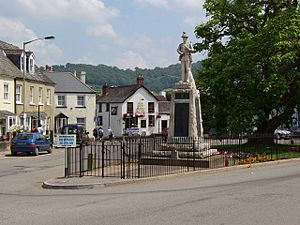Monmouth in the Mesolithic period facts for kids

Imagine finding proof that people lived in a town thousands of years earlier than anyone thought! That's what happened in Monmouth, a town in southeast Wales. In 2010, during some digging work, archaeologists found old tools and other items, called artefacts.
These artefacts, found at St James' Square and Wyebridge Street, included charcoal, flint pieces, and bits of bone. They showed that people lived in Monmouth during the Mesolithic period. This was the Middle Stone Age, much longer ago than anyone had believed! Monmouth is located where the River Monnow meets the River Wye. This discovery means people were living there thousands of years before we thought.
Contents
Discovering Ancient Monmouth
Before these new finds, the oldest known settlement in Monmouth was thought to be about 2,500 years old. But in 2010, workers were replacing gas pipes in St James' Square and Wyebridge Street. This digging caught the eye of local archaeologists.
These digging sites were once the banks of the River Wye. The river used to flow along what is now St James' Street. Archaeologists from the Monmouth Archaeological Society, like Stephen Clarke and Jane Bray, watched the work closely. They checked the trenches as the digging happened.
A Tiny Clue from the Past
While watching, Stephen Clarke noticed a tiny piece of charcoal. It was buried deep in ancient sand, below layers of Roman remains and river stones. This small piece of charcoal was a big clue! It made the archaeologists think there might be much older and more important things to find.
Amazing Finds: Stone Age Tools
The archaeologists kept digging and found more amazing things. They uncovered flint tools and bone fragments, along with more charcoal. Stephen Clarke contacted Elizabeth Walker. She is an expert in ancient history at the National Museum Wales in Cardiff.
Tools from the Middle Stone Age
Elizabeth Walker confirmed that the flints were from the Mesolithic era. This means they were made by people living around 6,500 to 7,500 years ago. Some of the tools were tiny flint pieces called microliths. These were sharp points for arrows or barbs for harpoons. People would have attached them to wood or antlers to hunt and fish.
Another tool found was a scraper. This tool could have been used to clean animal skins or to scrape bark from trees. Besides the tools, archaeologists also found waste pieces of flint. These were left over from when people made the tools.
What These Discoveries Mean

These discoveries showed that people lived in Monmouth thousands of years earlier than anyone had thought. The findings proved that the River Wye was a good spot for a camp during the Mesolithic era, also known as the Middle Stone Age.
Elizabeth Walker, the expert from the National Museum of Wales, first thought the tools were about 7,000 years old. She believed they were used by hunter-gatherers who used the river for food and travel. But after more study, she updated her idea. In November 2010, archaeologist Stephen Clarke announced that the finds were actually about 10,000 years old!
Nomads and Their Camps
Walker believed these early settlers were nomadic. This means they moved around a lot. She thought they might have lived near the river in winter and hunted in the hills during summer.
However, historian Jeremy Knight had a slightly different idea. He said that most known Mesolithic sites were near the coast. He thought these nomads spent their summers on the coast and moved inland for winter. This would make the Monmouth site the first known inland camp, where nomads might have spent their winter months.
Life After the Ice Age
Walker explained that after the Ice Age, the climate got warmer. Plants and trees grew back, and animals returned. People followed these animals to the British Isles. She also said that fish were an important part of their diet.
While similar finds had been made in Monmouthshire before, none were found right next to the river. Experts believe that temporary, nomadic settlements from that time were usually about 25 meters wide. Finding flints at two places, St James' Square and Wyebridge Street, suggests two possibilities: either the settlement was very large, or there were two separate Stone Age camps.
Scientists planned to use Radiocarbon dating on the charcoal. This test helps find the exact age of ancient materials. The dating was to be done at the Scottish Universities Environmental Research Centre. Wales & West Utilities, a large gas pipeline company, was expected to help fund this dating and the study of the excavation site.

